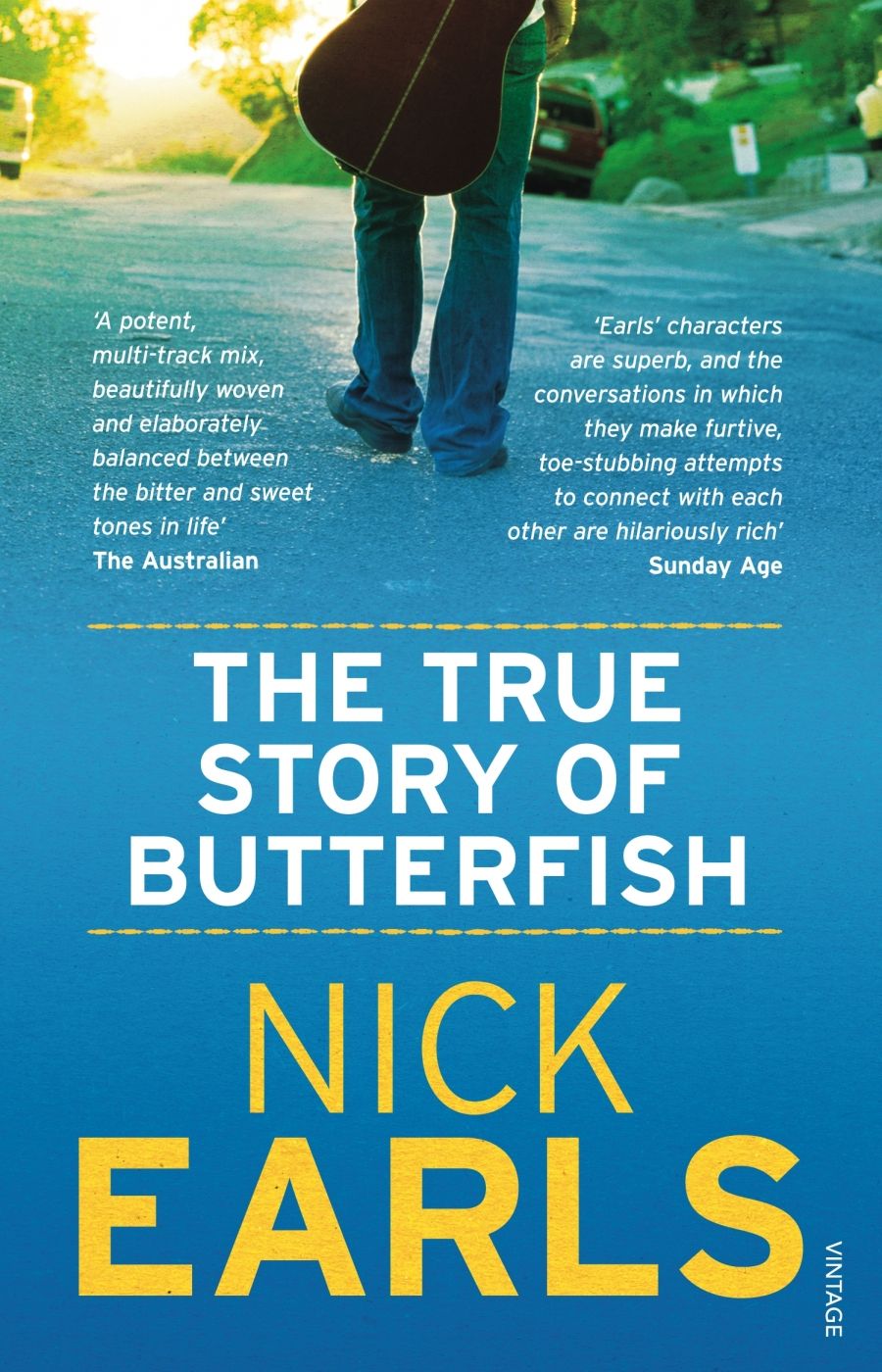
- Free Article: No
- Contents Category: Fiction
- Review Article: Yes
- Online Only: No
- Custom Highlight Text:
Though born and bred in Brisbane, I had never read anything written by Nick Earls prior to this assignment. The closest I had come was a book reading over a decade ago when Earls amused the audience with excerpts from his Bachelor Kisses (1998), before the late Grant McLennan beguiled them with an acoustic rendering of The Go-Betweens song of the same name. The Go-Betweens connection remains palpable in Earls’s latest novel, The True Story of Butterfish. The title of the failed third album of the fictional rock band Butterfish, Written in Sand, Written in Sea, can be nothing other than an allusion to ‘Man O’ Sand to Girl O’ Sea’, the song which rounds out Forster and McLennan’s classic record Spring Hill Fair. Beyond that, references abound to the streets, monuments and cloying humidity of the Queensland capital Nick Earls what to Brisbane as Lou Reed is to New York. Earls is also one of a long line of individuals Anton Chekhov, Stanislaw Lem, J.G. Ballard and others who gave up a career in medicine for a life of literary endeavour. Yet while the work of Ballard, to take the most contemporary example, includes disfigured bodies, transplanted limbs and exotic diseases, Earls seems to have left his life as a sawbones far behind. It is rather his misfortune to have been associated with the style known as ‘lad lit’, for which Nick Hornby is poster-boy.
- Book 1 Title: The True Story of Butterfish
- Book 1 Biblio: Vintage $32.95 pb, 288 pp
There is plenty in this new story in which a thirty-something musician returns home to Australia after the sudden disintegration of both his chart-topping band and his marriage to show that Earls is a fine writer. Turning good writing into good books, however, is quite another thing. It must be reported that The True Story of Butterfish is a largely pedestrian affair.
Nick Earls humanitarian, cat-lover and recently shortlisted (this could only happen in Queensland) for the state government’s ‘Top 150 Icons’ awards sounds like a lovely fellow. This may be part of the problem. If he had a genuine feel for the deviant side of human nature, the Lolita-esque subplot more Broken Flowers than Nabokov might have come across as less contrived. Perhaps the procession of bodily functions towards the end of the book might seem like the by-product of a card night with the boys.
Protagonist Curtis Holland is supposed to be descending out of the ‘clichéd rock dream’, and to that end the book certainly has all the rock clichés, not to mention the rock-fiction clichés, firmly in place. For example, there are God-awful group names such as Butterfish and The Splades, as well as song titles such as ‘Still Water’ (Stillwater, coincidentally or not, is the name of the imaginary band in Cameron Crowe’s film Almost Famous, 2000) and ‘The Light That Guides You Home’ (the lights of home being something of a motif in the narrative). There is also a former band member who arrives from Los Angeles to upset Curtis’s new-found suburban equilibrium with bad manners, rock-star drinking sessions and infidelity-fuelled fisticuffs.
Other traits situate the novel more centrally in the terrain initially staked out by Hornby in High Fidelity (1995). Characters debate music in what amounts to an instruction guide for the benighted. This is by the by when the usual Generation X ‘indie’ favourites are fawned over Jeff Buckley, The Shins but goes too far when Holland attempts to inculcate his nymphet neighbour, and anyone else who will listen, into the cult of early Billy Joel. Were I a physician, I would prescribe an urgent dose of Randy Newman, followed by a strict course of Richard and Linda Thompson, to assist in recovery from this particular 1970s singer-songwriter malaise.
Moreover, the story carefully transverses a Hornby-like ‘zone of cool’ between highbrow obscurantism and mass-culture pap. Appearing too cool, on this thinking, is the same as being uncool. Thus Werner Herzog’s Fitzcarraldo (1982) can be mentioned in dispatches between Curtis and his brother, so long as both admit to never having actually watched it, while disdain is expressed toward the name of a prospective opera because it sounds like ‘a book that would win the Miles Franklin but that only about ten people would read’. These are mostly personal irritants: others may be universal. The characters Annaliese and Mark seem particularly unbelievable, so unlike the typical disempowered, spindly adolescent (how many sixteen-year-olds refer to adults as ‘my friend’?) that you begin to wonder whether Earls resides in a child-free enclave. And what is it with the cooking obsession? Even those who are not yet weary of the whole Nigella-Masterchef-Hairy Biker subculture will surely baulk at earnest instructions on how to pan-sear a trout or dissertations on selecting the sharpest chef’s knife.
Earls puts his success down to ‘something in his books people can identify with’. If you are up for associating with a bunch of people who only drink Stella beer, google constantly and enjoy pontificating over tedious bands such as Asia and the Goo Goo Dolls, disregard everything you have just read. Otherwise, The True Story of Butterfish could well leave you a little cold.


Comments powered by CComment